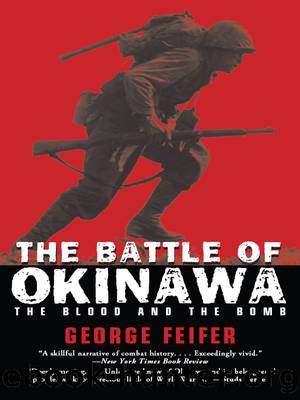The Battle of Okinawa by George Feifer

Author:George Feifer
Language: eng
Format: epub
ISBN: 9780762762545
Publisher: Lyons Press
Published: 2014-10-03T00:00:00+00:00
The sergeant knew Klingenhagen's very first action as a replacement on Sugar Loaf three days earlier had put him in a kind of shock. A mortar barrage killed his lieutenant and so ravaged his squad that only four men were able to withdraw. One of the four was badly wounded; another lasted only until he reached the bottom of the hill, when he fell dead at Klingenhagen's feet with a bullet hole in his chest. Yet although the eighteen-year-old private âsure hopedâ it wouldn't happen, he also knew he'd go up again if ordered.
A seasoned military maxim posits that a combat unit that has taken casualties of 30 percent or more can't sustain its fighting spirit. Many frontline units on Okinawa went far above that, Whitaker's 29th Regiment to 82 percent. However true it was (as many Japanese survivors later saw it) that Americans won their assured victory largely by applying their greatly superior resources, it's thus also true that those at the killing edge behaved exceptionally. Another old adage that war is 90 percent logistics didn't diminish their record of surpassing courage and esprit de corps.
Dick Whitaker was among the majority to whom it never occurred not to obey every order, and his wounds had been relatively trifling so far. Two days after his charge up Sugar Loaf on May 14, he and his platoon's other survivors were on the back slope of a little rise a hundred yards north. Exhausted and numb, they'd lost all their machine guns on the hill. Whitaker knew the wasted platoon would be ordered up again soonâbut maybe not now, maybe not until tomorrow. That was all the future they could contemplate.
Whitaker dug his foxhole deeper and stuck his shovel in the mud to light a cigarette. He leaned down toward a buddy's match, his left hand remaining on the shovel's handle. A sniper's bullet caught it there, exactly where his heart had been a second earlier.
He made his own way to his battalion aid station, about half a mile to the rear. Cleaned and dressed, his wound seemed less serious than when the bullet struck. Three days later, a doctor pronounced him fit for duty, and he returned to his unit, which was even smaller because it had charged Sugar Loaf again in his absence. (A month to the day after Whitaker was hit, Marine Corps headquarters in Washington wrote his parents that he'd been wounded in action against the enemy onâthis was mistaken by two daysâMay 18. âYour anxiety is realized and you may be sure that any additional details or information received will be forwarded to you at the earliest possible moment.â That moment came more than a month later, when the campaign was over and Whitaker was back on Guam. The new note informed that he'd been returned to duty on May 20.)
Two weeks later, the 4th and 29th Marine Regiments attacked the Oroku Peninsula, site of Naha Airfield and of the tunnels of the Naval Base Force and Captain Kojo's regimental headquarters.
Download
This site does not store any files on its server. We only index and link to content provided by other sites. Please contact the content providers to delete copyright contents if any and email us, we'll remove relevant links or contents immediately.
| Biological & Chemical | Conventional |
| Nuclear |
The Radium Girls by Kate Moore(11921)
100 Deadly Skills by Clint Emerson(4840)
Rise and Kill First by Ronen Bergman(4701)
The Templars by Dan Jones(4627)
The Doomsday Machine by Daniel Ellsberg(4415)
The Rape of Nanking by Iris Chang(4136)
Killing England by Bill O'Reilly(3951)
Hitler in Los Angeles by Steven J. Ross(3900)
Stalin by Stephen Kotkin(3875)
12 Strong by Doug Stanton(3508)
Hitler's Monsters by Eric Kurlander(3268)
Blood and Sand by Alex Von Tunzelmann(3138)
The Code Book by Simon Singh(3073)
Darkest Hour by Anthony McCarten(3070)
The Art of War Visualized by Jessica Hagy(2943)
Hitler's Flying Saucers: A Guide to German Flying Discs of the Second World War by Stevens Henry(2714)
Babylon's Ark by Lawrence Anthony(2620)
The Second World Wars by Victor Davis Hanson(2479)
Tobruk by Peter Fitzsimons(2442)
